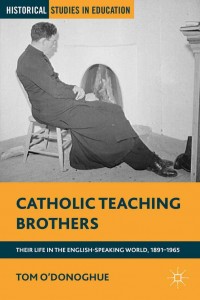Catholic teaching brothers: their life in the English-speaking world, 1891–1965
Published in Book Reviews, Issue 3 (May/June 2015), Reviews, Volume 23TOM O’DONOGHUE
Palgrave Macmillan
£61
Catholic teaching brothers is part of an interdisciplinary series, Historical Studies in Education, which features new scholarship on key historical developments in education. Offering a wide-ranging and insightful account of its subject, the narrative highlights the experiences of teaching brothers in five English-speaking countries: Ireland, England, the United States, New Zealand and Australia. The book operates within fairly broad parameters, being mainly concerned with an examination of the construction and regulation of the life of the teaching brother rather than with exploring the lived experiences of individual brothers. It focuses on the religious and teaching lives of brothers during a period when the Catholic Church built a remarkable collection of schools, including those run by the teaching brothers, notably the Irish Christian, De La Salle and Marist Brothers.
A key theme underpins the sweeping narrative: that the commitment of the brothers was first and foremost to their religious life, and that teaching, while seen as very important, would, if necessary, take second place. The period (1891–1965) was the ‘heyday’ of the religious orders and constitutes a distinct era in the history of the Catholic Church. The book is framed by two events that took place at the beginning and end of this era. In 1891 the Church began to move from opposing ‘Modernism’ to confronting it head-on. By insisting on having its own schools, the Catholic Church reflected the mood of intransigent defiance of what it saw as a hostile world. The provision of education was a major part of this project, and teaching religious, including teaching brothers, constituted the main teaching force in the schools that were established.
The main theme of the book, the primacy of religious life, is explored in various ways in the eight chapters of the book. Chapter One presents a broad historical background. Chapter Two outlines the Church’s involvement in education from the early days of Christianity, with particular focus on the great expansion of teaching orders in the period from the early nineteenth century until the early years after the Second Vatican Council (1962–5), including the role played by teaching brothers in the Church’s educational enterprise in countries such as the United States, England, Ireland, Australia and New Zealand. In the context of the nineteenth-century Irish diaspora, brothers (along with sisters and priests) responded to the requests of bishops desperate to establish and staff schools, providing the labour force that enabled the development and expansion of Catholic education systems in New World countries such as Australia and New Zealand. Three principal orders of teaching brothers take centre stage, the De La Salle, Marist and Irish Christian Brothers. As ‘pontifical’ orders they were theoretically free from the authority of bishops while being answerable to Rome. In Chapter Three the author describes ways in which the spiritual workforce of teaching brothers were identified as a ‘special group chosen by God’, and how they were constructed as religious through specific ways of living in community and adherence to vows of poverty, chastity and obedience. Chapter Four deals with the avenues utilised by the Church in recruiting members for the religious orders of brothers. Chapter Five provides an exposition of one of the most distinguishing characteristics of the life of a teaching brother: the authoritarian framework within which it was conducted. Chapter Six examines the worldview in which the brothers were immersed and how this shaped the educational mission adopted in their schools. Chapter Seven deals with the watershed changes brought about by the Second Vatican Council.
A reflection, ‘Looking backward, looking forward’, considers the implications of the movement away from ‘traditional’ Catholic practices that occurred as a consequence of the Second Vatican Council and analyses the Church’s attempt to respond to the challenges of the 1960s. These challenges were to result in major changes to the nature and purpose of religious life, including that of teaching brothers. This marks the second framing event of the book and the end of the period under consideration. Chapter Eight considers the significance of the exposure of a host of child-abuse scandals within Catholic schools, including those of the brothers. It details some of the darker side of life in schools run by the Church, including physical and sexual abuse, and presents an insightful account of some of the historical factors, including the punitive methods of religious formation and the depersonalising structures that prevailed in all-male religious orders. This is a hard-hitting analysis in which the author does not excuse the abuses but rather seeks to understand the factors that set up conditions for abuse, whereby some schools operated often out of public view or effective oversight, and with horrific consequences for children. Finally, Chapter Nine provides an overview of the book and suggests what the future may hold for the religious orders of teaching brothers.
Of the three types of teaching religious—priests, brothers and sisters—the brothers are least understood and the most neglected. Drawing on a range of documentary, oral and archival sources, Catholic teaching brothers makes an important contribution to an understudied area of Catholic education history. It raises important questions about the nature of teaching, the role of religion and culture and the darker forces at work in the lives of teachers. It identifies key avenues for future research and hopefully heralds a renewed interest in the kind of specialised historical investigation that will make visible the life and work of the individual brothers who undertook important educational work on behalf of the Catholic Church.
Reviewed by
Jenny Collins
Jenny Collins is Adjunct Professor at the Dept of Education at the Unitec Institute of Technology, Auckland, New Zealand.

















